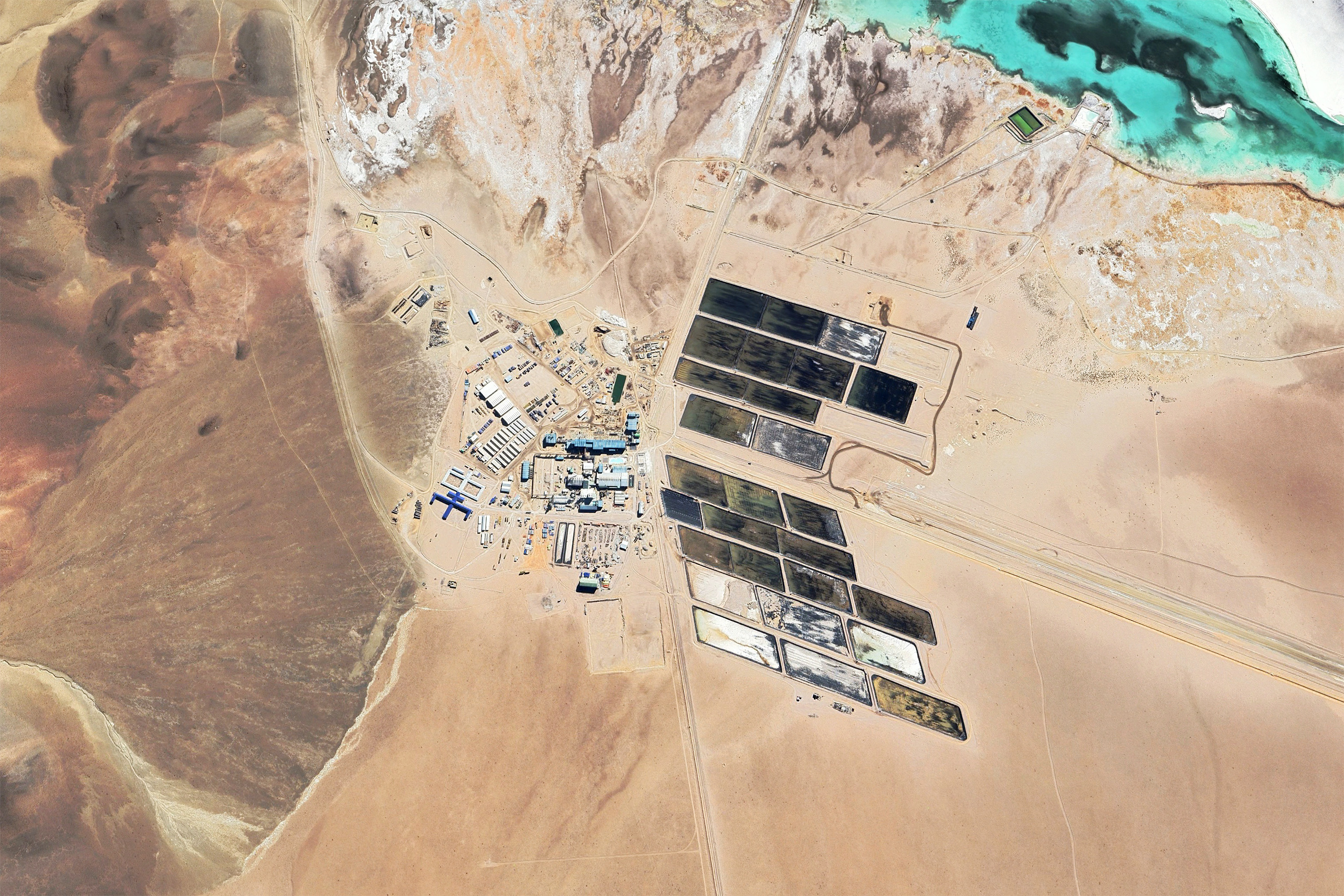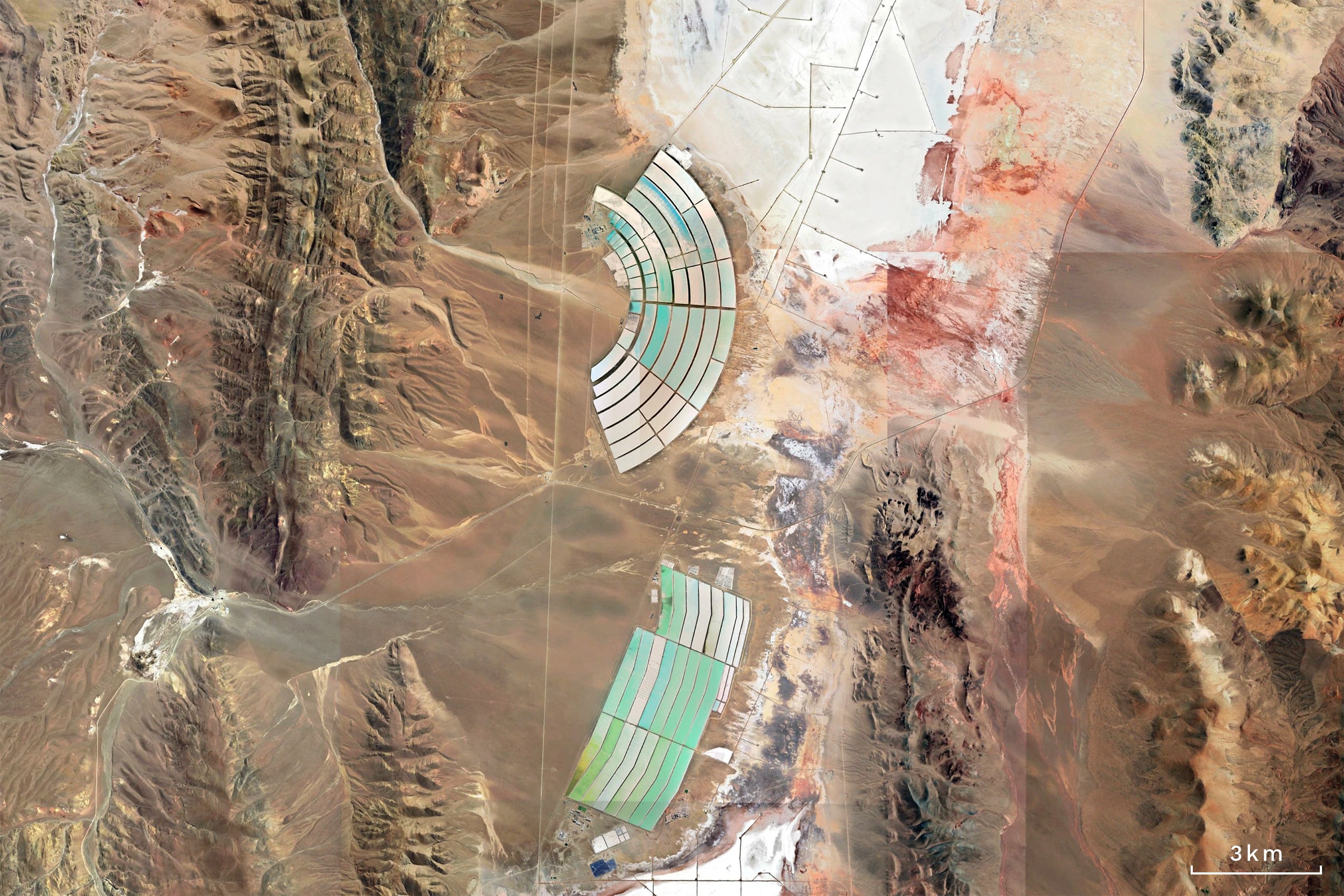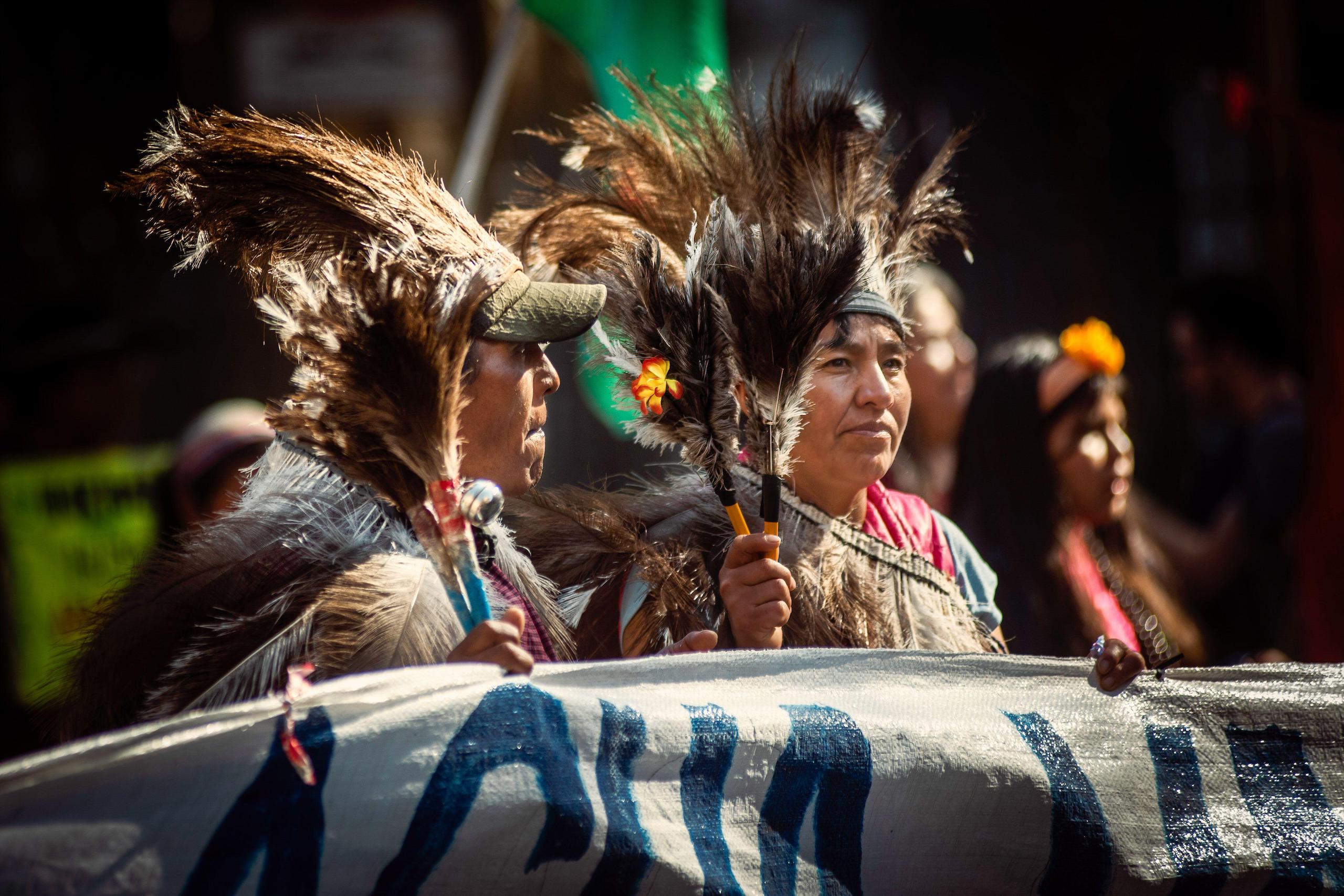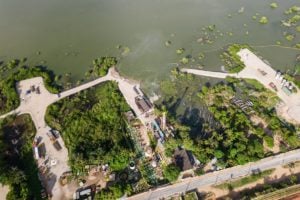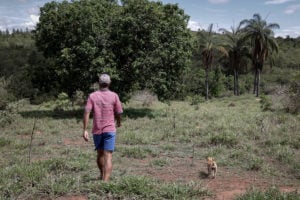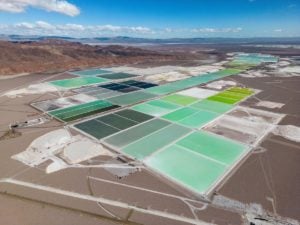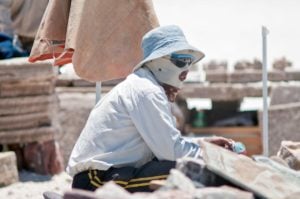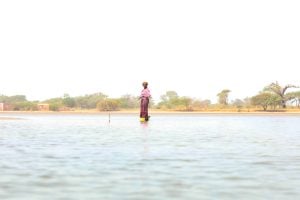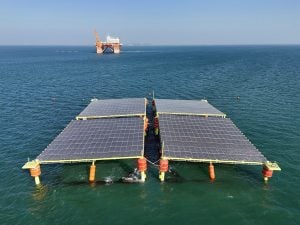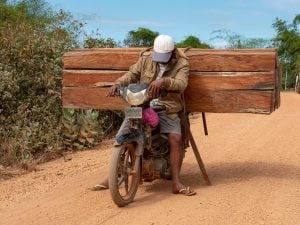Argentina’s lithium, with all its promises of bringing foreign currency and economic progress, is spread out across millions of hectares of unique ecosystems: salt flats.
Below these sparse expanses, located in the most arid areas of the country, sit many deposits of lithium-rich brine. These landscapes, known locally as salar, are heavily depended on by surrounding populations, as well as local flora and fauna, playing important roles in regulating climates and water cycles. Control over many of these salt flats is also claimed by various companies.
Argentina is the world’s fourth-largest lithium producer, and together with Chile and Bolivia, it forms part of South America’s so-called “lithium triangle”. The country alone has more than 20% of the world’s reserves of the metal, coveted by manufacturers of batteries for mobile phones, laptops and, in particular, electric vehicles, key to many of the global north’s green goals. So great is the rising demand, that lithium mining may be replicating some of the damaging historic patterns seen in the large-scale extraction of other minerals, experts told Diálogo Chino.
A recent survey conducted for the Pathways to Net Zero Project in Argentina – a joint initiative of the Earth Journalism Network, Banco de Bosques, Claves21 and Periodistas por el Planeta – has found the five lithium mining companies that may control the largest number of hectares of salt flats in Argentina.
Together, these multinational companies currently operate, own or have permission to explore for lithium – fully or jointly with their partners – on nearly one million hectares of salt flats in the northwestern provinces of Jujuy, Salta, Catamarca and La Rioja. As a result, they also have a great degree of control over the water around these salt flats, an issue which has in some cases been a source of tensions with nearby communities.
The survey took data from annual reports produced by the mining companies, along with information on official websites of the related provincial authorities and companies, and consultations with these entities. The data is based on the best available sources and may be subject to change.
First place: Litica
Over 320,000 hectares
Litica is the lithium division of multinational oil company Pluspetrol, owned by Argentine businesswoman Edith Rodríguez, widow of company founder Luis Rey. It is the third-largest oil company in the country, and its operations include blocks at the Vaca Muerta field in northern Patagonia. Rodríguez has also ranked as the richest woman in Argentina, with her family the country’s eighth richest, according to Forbes. The company was founded in Argentina but has been headquartered in the Netherlands since 2000.
According to our survey, the company currently has claims to over 320,000 hectares of salt flats nationally, which would give it the largest concentration by a single company in the country. Among the salt flats where the mining company is exploring for lithium are Río Grande, Arizaro, Pocitos, Diablillos, Salinas Grandes, Laguna de Guayatayoc, Palar and Pular, located across the provinces of Salta, Jujuy and Catamarca.
According to a market survey by mining company Integra Lithium, published in its latest annual reports, Pluspetrol acquired 234,500 of those hectares in its takeover of LSC Lithium for US$83.5 million in January 2019. It paid $356 per hectare across four of the salt flats now held by the company: Pozuelos, Pastos Grandes, Río Grande and Salinas Grandes.
One of these salt flats, Salinas Grandes, is perhaps the most contentious in the country. Lithium exploration in the area, in the province of Jujuy, has been the subject of litigation since 2010, when a group of 38 Indigenous communities organised protests, roadblocks, and launched administrative and judicial cases against projects. Their efforts have so far halted the progress of mining companies in the large salt flat.
The communities had been spurred on by warnings from scientists and environmental organisations about the potential environmental impacts of lithium extraction, and the risks it can pose to the fresh water supply for themselves, their animals and their crops. The communities’ other economic activities in the salar – including community-based tourism, and salt extraction for consumption and industrial uses – are also threatened by mining activities, say Indigenous leaders who have resisted exploration here, such as Clemente Flores and Verónica Chávez.
Despite such opposition, Litica has obtained approval from Sauzalito y Quera and Agua Caliente, two Indigenous communities located in Salinas Grandes – once voted as one of the Argentina’s “seven natural wonders” – and Laguna de Guayatayoc, to begin operations, according to a source from the mining sector who asked not to be identified. The company did not respond to requests for comment on the status of its projects in either locations.
Second place: Arcadium Lithium
At least 232,637 hectares
A new company, Arcadium Lithium, comes in at second place. It is the result of the January 2024 merger of two foreign-owned mining companies, the USA’s Livent and Australia’s Allkem. The merger made Arcadium the third-largest lithium producer in the world.
Together with other partners, Arcadium Lithium is leading two projects in the Argentine lithium market, and has control on at least 232,637 hectares of salt flats, according to calculations based on various studies published by Allkem. This would give it the second-largest concentration of salt flats in the country. Arcadium Lithium operates two of the three projects in Argentina currently producing and exporting lithium and its derivatives, lithium carbonate and lithium chloride: Fénix, in the Hombre Muerto salt flat in Catamarca; and Sales de Jujuy, in the Olaroz salt flat.
Among the owners of these mining companies are four of the world’s largest asset managers – Blackrock, HSBC, JP Morgan and Vanguard – along with a wide cast of international shareholders, according to an investigation by the NGOs Ruido and Fundeps.
The merger of Livent and Allkem into Arcadium Lithium “generates a certain concentration of lithium production in the country,” says Víctor Delbuono, a researcher in mining and public policy at sustainable development thinktank Fundar.
Delbuono, who was previously director of mining economics for the country’s mining secretariat, adds that the global lithium market is “oligopolistic”, concentrated among a group of Canadian, Australian and US companies, along with Chile’s SQM and, increasingly, Chinese companies.
Both Allkem and Livent have faced legal challenges in Argentina. Last year, the Federal Administration of Public Revenues (AFIP) denounced the mining company Galaxy Lithium, absorbed by Allkem in 2021, alleging tax evasion and “misleading” financial statements with respect to its lithium exploitation in Catamarca. Between 2022 and 2023, Livent faced cases for two different events: a hydrochloric acid spill at the Fénix project mine, and also an alleged underreporting of its exports of lithium carbonate in order to lower its contributions to the state.
We are destroying a unique ecosystem that has biological information about the origin of lifeMelisa Argento, researcher at the National Council for Scientific and Technical Research
Livent has also faced long-running conflict with communities living near the salt flats they control, who allege that the company’s activities are causing water stress. “Livent has been extracting lithium from the Salar del Hombre Muerto for 25 years… Communities have been complaining for a long time that the plains of the nearby Trapiche River are dry,” explains Melisa Argento, a researcher at the National Council for Scientific and Technical Research (CONICET).
“We are destroying a unique ecosystem that has biological information about the origin of life,” says the researcher.
She refers to the presence in Catamarca of stromatolites, layered deposits formed by photosynthesis of bacteria, often described as living fossils, adding that the area is “considered the closest thing to Mars in terms of composition and climate.”
Livent was approached for comment but had not responded at the time of publication.
Third place: Integra Lithium
At least 163,000 hectares
Integra Lithium is a division of Integra Capital, the investment company owned by José Luis Manzano, an Argentine businessman and former politician. He is part-owner of Edenor, Metrogas, the oil company Andes Energía (now known as Phoenix Global Resources), the electricity company Andina PLC, as well as several radio and television channels in Argentina. He was Minister of the Interior under former president Carlos Menem in the 1990s.
In its latest annual report, published in January 2024, Integra Lithium says that, in addition to controlling 163,000 hectares of salt flats in Jujuy and Catamarca, it has added 333,000 hectares in the Altos Sapitos and Macasin salt flats in La Rioja to its portfolio.
With the inclusion of this area in La Rioja, Integra Lithium would place first in the ranking, at a total of 496,000 hectares. However, as a result of legal reform in the province, Integra Lithium only shares an exploration permit with provincial state-owned mining company EMSE, which retains ownership of the land, says provincial secretary of mining Ivanna Guardia. “It may be that mining companies use the term ‘concession’ ambiguously, but many times they only have exploratory permits,” says Guardia.
In La Rioja, lithium was declared a strategic resource in December 2022 – a decision which enabled the government to suspend existing exploratory permits and concessions and set up its own mining company to search for lithium.
Integra Lithium declined an approach for comment on the situation.
The company is also looking for lithium beyond the salt flats – exploring for deposits over 77,000 hectares of hard rock in Catamarca province’s Sierra de Ancasti mountain range, according to its latest annual report.
Fourth place: Ganfeng Lithium
At least 122,432 hectares
Chinese miner Ganfeng Lithium and its Argentine associate EXAR – a partnership with Lithium Americas of Canada, and Jujuy state-owned JEMSE – have control over at least 122,432 hectares of salt flats in Salta and Jujuy, according to information published by the company, media and the Salta government. Their exploration permits allow them to search for lithium in the Llullaillaco, Pozuelos, Incahuasi, Cauchari-Olaroz and Sal de la Puna salt flats.
In July 2022, the company acquired 32,000 of these hectares in the Pozuelo and Pastos Verdes salt flats for $962 million, at just over $30,063 per hectare – the highest per-hectare figure recorded in Integra Lithium’s market survey.
Ganfeng and EXAR were approached for this article, but did not respond to requests for comment.
Fifth place: Rio Tinto
83,000 hectares
British-Australian multinational miner Rio Tinto is the company ranking fifth in terms of salt flat control, with a reported 83,000 hectares in Salar del Rincón in Salta province, according to an announcement by the British business chamber in Argentina. The figure was confirmed by the company.
The mining company acquired the hectares for $825 million in March 2022, with each hectare in Salar del Rincón costing $9,940.
In January, the company was preparing to begin construction of a processing plant with a capacity of 3,000 tonnes of lithium per year in Salta, as reported by local financial outlet Ámbito Financiero.
Breaking down the numbers
Trends in exploration concessions and permits granted show a high percentage of salt flats are in foreign hands. Typically, “foreign mining companies generate a local subsidiary domiciled in Argentina, which buys the land – but the real owners are foreign capital,” CONICET researcher Argento explains. For example, Ganfeng operates through EXAR, an Argentina-registered entity.
Furthermore, salt flats are not homogeneous, Argento notes, with differing levels of lithium concentration, explaining why different properties have commanded different prices. “There are climatic conditions, the composition of the salar and the conditions in which the lithium is found, and how easy it is or is not to extract it,” she says. “These dimensions make each salt flat different.”
Other variables such as logistics and access to infrastructure may also affect the price of hectares and the feasibility of the projects, including factors like the presence of a nearby road, and whether there is grid connectivity, access to a high voltage network and gas pipeline, Delbuono explains.
It is a speculative business encouraged by the mining regime that exists in ArgentinaAriel Slipak, research coordinator for the Environment and Natural Resources Foundation
Not all mining companies report how many hectares of salt flats for which they have concessions or the size of the area they are exploring; those that do report do not distinguish between these areas and permits, so it was not possible to differentiate between them for the survey. Not reporting this “is a question of marketing”, explains a source from the mining sector who asked not to be identified.
For years, many salt flats in La Rioja remained in the hands of private companies that obtained exploration permits and obtained successive extensions but never really explored the area for minerals, says Guardia.
“In lithium mining, as in other types of mining, we see companies accumulating hectares of land, applying for mining claims and then claiming that they have deposits from which high-purity lithium carbonate can be extracted, and selling these projects to large companies with the capacity to exploit them,” says Ariel Slipak, research coordinator for the Environment and Natural Resources Foundation (FARN), an Argentine NGO. “It is a speculative business especially encouraged by the type of mining regime that exists in Argentina.”
In Argentina, many Canadian and Australian mining companies are small-scale and engage in exploration work, assessing how much lithium could be extracted, and how it can be extracted, Argento notes. “These permits are sold and bought all the time.
“With permits, hectares change hands,” she says, adding that problems arise as mining regulations allow buying and selling, “facilitating a highly speculative logic about the projects and making environmental controls and regulations more flexible.”
Water and territory
“In lithium mining, what matters most is water,” Argento says. These ecosystems are a type of wetland and regulators of local climate and waters, so “their destruction not only affects local communities, but the whole of the population,” she adds. As salt flats are formed within endorheic basins – those which have no outflow to external bodies of water – they filter water through surrounding soil and rock, upon which animals drink and pastures are irrigated.
As water on the salt flats evaporate, they leave behind brines, underground pools that lie beneath the salt crusts and which are rich in lithium, potassium, magnesium, calcium, boron and other chemical elements, as Argento and Slipak explained as co-authors of a chapter of a book on the energy transition in Argentina. These are a central source of water for the surrounding areas and all that inhabit them, in some of the most arid regions of the country.
Almost the entire surface area of the salt flats and their bordering territories in the provinces of Jujuy, Salta and Catamarca has been requested for exploration by companies for lithium, the authors note.
Amidst this lithium rush, various observers have raised concerns over the potential for displacement or conflict with communities. Argento, who has travelled through multiple areas in which lithium companies have acquired or been granted control, reports that some residents already claim to have encountered such issues, in some cases on lands to which they contest ownership. Water usage has been the notable flashpoint around which community opposition has centred.
“We have to demystify the idea that the salt flat is empty territory,” she adds. “It is not empty – people live there. People who have been saying for years that all environmental, social and human rights are being violated in these territories. They organise themselves in resistance, to confront a profound asymmetry of power with capital.”
This article was produced in partnership with El DiarioAR.



